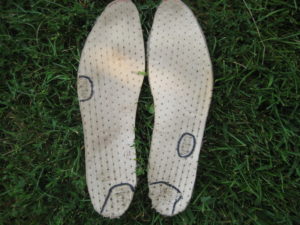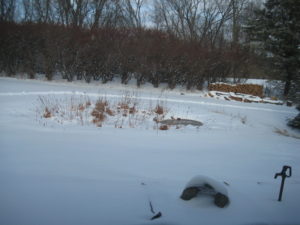Animal Tracking Part II: We Are All Individuals

My somewhat worn field boot liners
This week’s snow captures tracks quite well. An early step to tracking animals is to first track humans. And one of the lessons to be learned is how much we are all individuals, even down to our tracks.
You can see the result of your own walking or running style by looking at the wear pattern in an older pair of your shoes. Using myself as the example, the photo below shows a pair of liners taken from my field boots. The places where the fabric is wearing through are circled in black marking pen. Note that I strike first slightly on the inside of my heels and then roll to the outside midstride and leave no wear on the toes (and lose efficiency by not pushing off, due to an old injury).

Even in only a few inches of snow, and from a distance, my track across the yard looks like a pair of furrows with little piles pushed up from ploughing through.
Note that the most focused wear is centered on the backs of the heels, and if you watched, you would see me to be a heel dragger, because I barely lift my feet off the ground and mainly slide them forward. My footprints in snow are very parallel and nearly three feet long and almost looks like a wide ski trail. Behind all this is knee damage, which I’ve had as a child, and compensate in part by heel dragging.
And most of us have our own package of irregularities, which our bodies try to compensate for. For example, we all try to keep our eyes level while walking, and this translates to special motions of our hips, knees, ankles, and feet.
In order to see these translate to foot motion, it is instructive to walk behind other people and watch their feet. Easy to do inconspicuously at the mall or on campus. The most obvious difference among people is toe in vs toe out patterns. For example, you may find that heavy people tend to toe out, but there are numerous exceptions.
My reason for dragging you through these details is that the same constraints apply to the other critters. A herd of deer may all initially seem alike, but in detail each has its own asymmetries that it compensates for in its unique way. In addition to its birth asymmetries, individual deer have gotten snagged on barbed wire, clipped by cars, stepped on broken glass, gotten bit by dogs, fought amongst themselves, run into honey locust thorns, etc.
Some twenty years ago, my role in the Snyder Creek Project on the southeast edge of Iowa City included evaluating a small local herd of deer with a high power spotting scope. One deer left quite a distinctive trail pattern in the snow and then I realized that I could recognize it in person by how it walked and ran. Then I got a good look at its face and found that it was blind in one eye and constantly turning its head for better peripheral vision. Later that winter it disappeared, perhaps a victim of an oncoming car, or a coyote who figured out its blind spot.
Nature is very fine-tuned In this regard because individuals get challenged regularly. The bunny who lives in your bushes has to deal almost daily with cats or dogs or owls or hawks or automobiles or, …, and it only requires one mistake to become a Darwinian statistic.
If you don’t remember how a creature’s body plan affects the collective shape of its track pattern, snowy days are a good time to review Animal Tracking Part I: Body Plans.


